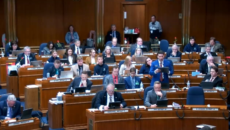Dorso Column: North Dakota's Executive Branch Is Too Involved In Legislating
The state capitol building in Bismarck is a unique design. But it is what that design signifies or tells that makes it so important. I hope every legislator now and into the future reads this piece. When they or elected officials walk the halls of the capitol I hope they are reminded of the sacrifice the people of North Dakota went through, beginning construction in 1932 at the height of the depression.
The architects Joseph Bell DeRemer and W.F. Kurke gave us a beautiful structure and a lesson in government. If you start at the far west end of the Great Hall and walk to the east you see first the legislative chambers on both sides of the hall. The entrances to the chambers are on the same floor and across from one another signifying they are co-equal parts of the legislative body.
After passing the chambers you are in an atrium or large hall with glass on its south exposure that reaches up a couple of stories. The view facing south down a large mall always reminded that it was a welcoming spot for the citizens to gather and petition their government. Over the years many rallies in support or against a legislative initiative have been staged on the steps and mall leading up to the Great Hall. The vast expanse of glass allows for a great deal of sunshine reminding us of the openness of North Dakota government.
I believe the length of the hall between the legislative chambers and the tower where the executive branch resides is there for a reason. There is a clear demarcation between the branches of government. As I have said many times the legislature is the people’s branch of government. A reading of the state’s constitution makes it clear the framers intended it to be the case. The legislature is also the policy making branch of government. The executives in the tower are there to carry out the will of the people as developed by the people’s branch.
The first offices in the tower you come to on your walk east are the Governors, the Attorney Generals and the Sec. of State. They are all on the same floor as the legislative branch and serve to remind us they are the most powerful of our states elected officials.
Continuing east you come to the North Dakota Supreme Court chambers which are also on the same floor.
If you make this walk from west to east you should be struck with the fact that you can see all three branches of government from one vantage point. You should also come away with the feeling the designers were trying to convey the thought that the branches of government are equal but separate.
Which brings me to an issue that has bothered me for some time. I think the legislature has let the executive branch get too involved in its deliberations. I can remember the time when an elected official did not appear at a committee hearing unless they were requested to do so by the chairman of a committee. Their deputies would be at the hearings sometimes giving testimony but most of all they were there as a research person and observer.
Governors never appeared in the legislative chambers unless it was for an occasion such as the state of the state address or to deliver their budget message. In fact the governor’s office always sent a letter requesting the legislature’s approval of the date and time for those occasions.
On page 37 of my book I relate a story about Gov. Schafer wanting to speak to the House Republican Caucus during a legislative session. I told him at one of our weekly breakfasts that it wasn’t going to happen. He then called the Caucus leader who asked me again and I not very politely said no. It wasn’t that I didn’t get along with the Governor it was that there is a separation of powers that should be a bright line. If governors or other elected officials want to lobby the legislature they should do it by requesting a meeting with legislators in their offices.
Once a legislator told me the governor had requested a meeting about a particular issue. He wanted to know how I felt about those meetings. My answer was that if he felt comfortable talking with the governor on the issue he should go out of respect for the office. If he was uncomfortable it was his prerogative to politely decline the invitation.
In Chapter 12 of the book I describe how PSC commissioners Wefald and Sandstrom were in the chambers constantly as we deregulated telecommunication. In my opinion they hurt their case significantly. How could they have that much time on their hands to be spending hours day after day lobbying their position on the issue? In the main they polarized the discussion making it easy to pass the legislation they opposed.
If a Republican elected official wanted to get my dander up it was to use the phrase “you should support this because we are all Republicans”. That better have been the last argument on the subject because they were only moments from being shown the door. If they couldn’t make a case based on the merits of the bill and how it would be good for North Dakota, playing the GOP party card wasn’t going to cut it.







